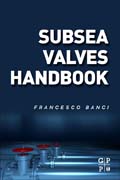
Subsea Valves Handbook helps engineers and managers understand the types of valves that are specific to various subsea applications, including their critical functions and a focus on cavitation and flushing effects that is essential for today's deepwater and high temperature wells. Operating offshore valves has its own set of challenges, including harsher environments, more remote locations, and higher maintenance costs. This book delivers knowledge on lifetime estimations and design extension considerations, validation/verification testing during installation, integration obstacles, and safety and reliability monitoring points. Industry standards and the data behind their specifications are listed for easy reference, as well as basic definitions and abbreviations. Users will find a reference that successfully bridges the knowledge gap for any engineer and manager working specifically in subsea oil and gas. Presents how subsea valves differ from other valves in the industry, including subsea master valves, wing valves, and choke valvesProvides information on the various industry standards specific to subsea valves and why these requirements are neededExplains technical background, and testing and installation considerations that are critical for today's higher degree of offshore regulations INDICE: 1. Scope2. Terms, Definitions, and Abbreviations3. Subsea System Description4. Functional Considerations5. Safety and Reliability Considerations6. General Design Features7. Specific Application Considerations8. ROV Intervention Considerations9. Materials and Fabrication Considerations10. Deepwater and/or Long Tie-Back Considerations11. HP/HT Considerations12. Long Design Life Considerations13. Testing Considerations
- ISBN: 978-0-12-805466-6
- Editorial: Gulf Professional Publishing
- Encuadernacion: Rústica
- Páginas: 320
- Fecha Publicación: 01/11/2017
- Nº Volúmenes: 1
- Idioma: Inglés
